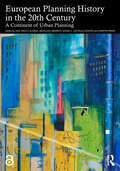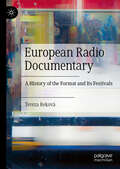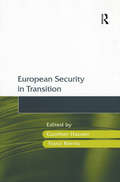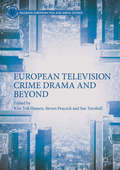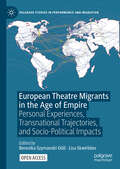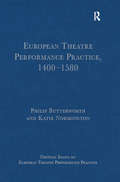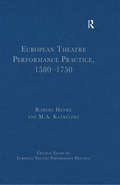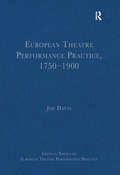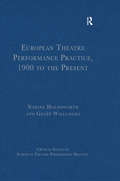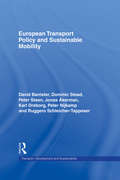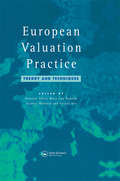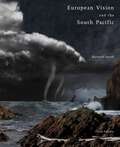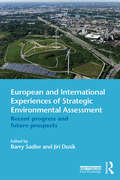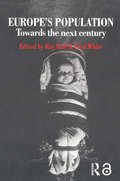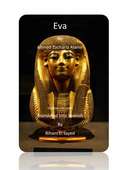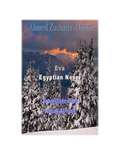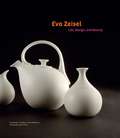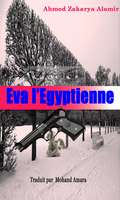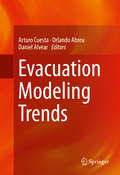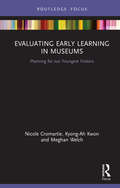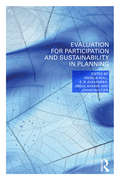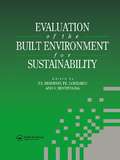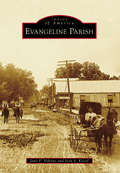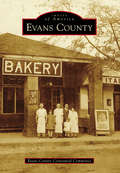- Table View
- List View
European Performative Theatre: The issues, problems and techniques of crucial masterpieces
by Annamaria CascettaPerformative theatre is one of the most important trends of our time. It is emblematic of the work of many European theatrical artists in the early twenty-first century. Annamaria Cascetta does not propose a model or a historical overview, but rather strives to identify the salient features of a significant trend in the theatrical research and transformation of our time by analysing some crucial examples from outstanding works, of great international resonance. She draws on work by artists from different generations, all active between the late twentieth century and the first decades of the twenty-first, and in various European countries, performed in a number of European theatres in recent years. The aim is to apply a method of analysis in depth, bringing out the technical elements of contemporary "performative theatre" in the field, and above all to highlight the close links between it and the urgent and troubled issues and problems of history and society in the phase of cultural and anthropological transition we are experiencing.
European Planning History in the 20th Century: A Continent of Urban Planning
by Max Welch Guerra Abdellah Abarkan Martin Pekár Castrillo Romón, María A. Victoria GrauThe history of Europe in the 20th century is closely tied to the history of urban planning. Social and economic progress but also the brute treatment of people and nature throughout Europe were possible due to the use of urban planning and the other levels of spatial planning. Thereby, planning has constituted itself in Europe as an international subject. Since its emergence, through intense exchange but also competition, despite country differences, planning has developed as a European field of practice and scientific discipline. Planning is here much more than the addition of individual histories; however, historiography has treated this history very selective regarding geography and content. This book searches for an understanding of the historiography of planning in a European dimension. Scholars from Eastern and Western, Southern and Northern Europe address the issues of the public led production of city and the social functions of urban planning in capitalist and state-socialist countries. The examined examples include Poland and USSR, Czech Republic and Slovakia, UK, Netherlands, Germany, France, Portugal and Spain, Italy, and Sweden. The book will be of interest to students and scholars for Urbanism, Urban/Town Planning, Spatial Planning, Spatial Politics, Urban Development, Urban Policies, Planning History and European History of the 20th Century.
European Radio Documentary: A History of the Format and Its Festivals
by Tereza RekováThis book studies the history and significance of radio documentaries in Europe, and the institutions that are specialized on this genre. Focused on the 50-year history of the International Feature Conference (an annual gathering of radio documentarians from around the world), the book discusses the Prix Europa, Prix Italia, the Third Coast International Audio Festival, and the HearSay Audio Arts Festival. The book tells the story of people who chose sound as their lifestyle and who spread their passion worldwide.
European Security in Transition
by Franz KernicSince the end of World War II, security and defence have played a major role in European politics. With the European Union's increasing role on the global stage and with today's war on terrorism, security and defence issues have dramatically gained weight and importance in international politics. This compelling volume provides an interdisciplinary look at the development and current status of the European security system as well as selected key issues on today's security agenda. As such, it provides an excellent resource for those wishing to make sense of the complexities of defence and security issues in the European Union at a time of global change.
European Television Crime Drama and Beyond (Palgrave European Film and Media Studies)
by Steven Peacock Kim Toft Hansen Sue TurnbullThis book is the first to focus on the role of European television crime drama on the international market. As a genre, the television crime drama has enjoyed a long and successful career, routinely serving as a prism from which to observe the local, national and even transnational issues that are prevalent in society. This extensive volume explores a wide range of countries, from the US to European countries such as Spain, Italy, the Scandinavian countries, Germany, England and Wales, in order to reveal the very currencies that are at work in the global production and circulation of the TV crime drama. The chapters, all written by leading television and crime fiction scholars, provide readings of crime dramas such as the Swedish-Danish The Bridge, the Welsh Hinterland, the Spanish Under Suspicion, the Italian Gomorrah, the German Tatort and the Turkish Cinayet. By examining both European texts and the ‘European-ness’ of various international dramas, this book ultimately demonstrates that transnationalism is at the very core of TV crime drama in Europe and beyond.
European Theatre Migrants in the Age of Empire: Personal Experiences, Transnational Trajectories, and Socio-Political Impacts (Palgrave Studies in Performance and Migration)
by Berenika Szymanski-Düll Lisa SkwirbliesThis open access edited volume constitutes the first historical study of the phenomenon of European theatre migration, and thus contributes in new and important ways to the formation of a historical discourse on theatre and migration. The hidden histories of European theatre migration that this book seeks to explore allow us to rethink global theatre history as a history of mobility with Europe as the point of departure rather than the point of arrival. It also allows the reader to challenge and to decenter a European self-understanding of insularity and a European cosmopolitanism ignorant of its imperial and colonial roots.
European Theatre Performance Practice, 1400-1580 (Critical Essays on European Theatre Performance Practice)
by Philip ButterworthThis volume brings together important records of medieval theatre practice between 1400 and 1580. The records are drawn from a wide range of spheres including civic, ecclesiastical, trade and guild records and consist of payments for materials, techniques and services; also included are some eye witness accounts. Alongside these records is a selection of the best contemporary research conducted into medieval performance practice, which features ground-breaking analysis and challenges current understanding, knowledge and authority in this field. These contributions of rigorous scholarship complement and support the work of the well-known Records of Early English Drama project and help to further illuminate contemporary fifteenth and early sixteenth-century theatre performance practice.
European Theatre Performance Practice, 1580-1750 (Critical Essays on European Theatre Performance Practice)
by Robert HenkeThis volume presents foundational and representative essays of the last half century on theatre performance practice during the period 1580 to 1750. The particular focus is on the nature of playing spaces, staging, acting and audience response in professional theatre and the selection of previously published research articles and book chapters includes significant works on topics such as Shakespearean staging, French and Spanish theatre audiences, the challenging aspects of the evolution of Italian renaissance acting practice, and the ’hidden’ dimensions of performance. The essays provide coherent transnational coverage as well as detailed treatments of their individual topics. Considerations of theatre practice in Italy, Spain and France, as well as England, place Shakespeare’s theatre in its European context to reveal surprising commonalities and salient differences in the performance practice of early modern Europe’s major professional theatres. This volume is an indispensable reference work for university libraries, lecturers, researchers and practitioners and offers a coherent overview of early modern comparative performance practice, and a deeper understanding of the field’s major topics and developments.
European Theatre Performance Practice, 1750–1900 (Critical Essays on European Theatre Performance Practice)
by Jim DavisThis volume contains key articles and chapters which represent both seminal and innovative scholarship on European theatre performance practice from 1750 to 1900. The selected topics focus on acting and performance, staging (including set design and lighting), and audiences, and are approached with a broad perspective as well as with in-depth, focussed analysis. The volume captures the rich, dynamic and variegated nature of European theatre throughout the late-eighteenth and nineteenth centuries and provides a carefully selected body of significant texts on this important period of theatre history.
European Theatre Performance Practice, 1900 to the Present (Critical Essays on European Theatre Performance Practice)
by Geoff WillcocksThis volume captures the rich diversity of European performance practice evident in the twentieth and early part of the twenty-first century. Written by leading directors, actors, dancers, scenographers and academics from across Europe, the collection spans a broad range of subject areas including dance, theatre, live art, multimedia performance and street protest. The essays are divided into three sections on: performers and performing; staging performance; representation and reception, and document innovations in acting, performance and stagecraft by key practitioners. Articles also explore the ways that performance has been used to stage debates around major preoccupations of the age such as war, the human condition, globalization, the impact of new technologies and identity politics. This volume, which features previously published performance manifestoes, articles, and book chapters on the most frequently discussed and debated topics in the field, is an indispensable reference work for both academics and students.
European Transport Policy and Sustainable Mobility (Transport, Development and Sustainability Series)
by Peter Nijkamp Dominic Stead David Banister Jonas Akerman Karl Dreborg Ruggero Schleicher-Tappeser Peter SteenIt is now widely accepted that transport is becoming increasingly unsustainable and that strong policy intervention is required to reduce both the growth in transport demand and the environmental costs of transport. This book challenges conventional approaches to transport by moving away from trend based analysis towards the use of scenarios to identify alternative sustainable transport futures. It both summaries the development of EU transport policy and presents a critique. The policy context is widened to include the global changes taking place in economics, society and technology. It develops new methodologies for policy making for the next 25 years.
European Valuation Practice: Theory and Techniques
by A. Adair M.L. Downie S. McGreal G. VosThe variability of valuation practice within Europe is perceived as a problem within the globalization of property. This edited textbook examines the practice of real estate valuation in selected countries in Europe. The focus is on countries with well developed real estate markets in which both international and indigenous investors are active. The book is aimed at real estate professionals, financiers, institutional advisers, property researchers and students who require a greater understanding of comparative property appraisal techniques applied across Europe.
European Vision and the South Pacific Third Edition
by Bernard SmithBernard Smith (1916-2011) was arguably Australia's greatest art historian and one of the most important humanist thinkers internationally on ideas concerning cultural contact. His European Vision and the South Pacific, first published in 1960, showed how the ideas of the Enlightenment and the empirical structuring of scientific and geographical knowledge during the great eighteenth-century voyages of discovery affected notions of identity-both for Europeans and the Indigenous peoples with whom they came in contact. Not only did Smith's investigation of art, science and imperialism of this period explore the conditions of frontier contact, it opened up the dialogue on de-colonisation and allowed us 'to think beyond or after it'. He was undoubtedly a pioneer of post-colonialism and the book remains 'a lighthouse' in pacific studies. The republication of European Vision and the South Pacific is an essential part of the discourse reframing the interconnections and crossing of cultural boundaries between Europe and antipodean societies. This new edition of a significant Australian classic also coincides with the 250th anniversary of Cook's landing on the east coast of Australia, and complements new scholarship on territorialisation, colonialism and the politics of exchange between metropolitan centres and peripheries. A new introduction by Sheridan Palmer situates the book in a contemporary context.
European and International Experiences of Strategic Environmental Assessment: Recent progress and future prospects
by Barry Sadler Jiří DusíkThis book brings together the latest thinking in Strategic Environmental Assessment (SEA) and considers the key question of whether the processes are having a positive impact on strategic decision making, both in Europe and worldwide. As governments move to develop green agendas, the book explores the challenges of working within national systems, as well as the strengths and weaknesses of sector-specific SEA. The importance of stakeholder engagement is considered, as is the question of how to turn NIMBYs into WIMBYs – that is, creating positive reasons to encourage development and allow local stakeholders to profit. In assessing ways in which the practice of SEA can provide a new agenda for the 21st Century, the chapters explore current and emerging approaches, procedures and methods, along with ways in which SEA can be linked with other planning tools. The role of research and academia is considered, and the book looks beyond the current status of SEA to address the question of how practitioners can capitalise on the potential of SEA to become integrated into high-level policy as a key element of climate change mitigation strategies. Each chapter is written by internationally renowned authors and based on many years of experience in the field. The book will be essential reading for forward-thinking practitioners and students of SEA.
Europes Population: Towards The Next Century
by Paul White Ray HallFirst published in 1995. Routledge is an imprint of Taylor & Francis, an informa company.
Eva
by Ahmed Zakarya Alamir Riham El SayedLa historia se narra de Egipto en Los años sesenta hasta nuestra día a través la vida de una mujer científica que se llama Eva.
Eva Egyptian Novel
by Ahmed Zakarya Alamir Amal Al-SaifIt is a work of fiction with a biographical element about an Egyptian woman, Eva. She was a scientist who faced a tragedy in her life for the sake of her dream. The author reflects a period of conflict in the modern history of Egypt.
Eva Zeisel
by Pat Kirkham Pirco Wolfframm Eva Zeisel Brent C. Brolin Pat MooreEva Zeisel was one of the twentieth century's most influential ceramicists and designers of modern housewares. Her distinctive take on modern industrial design was inspired by organic form and brought beauty and playfulness to housewares, earning her designs a beloved place in midcentury homes. This richly illustrated volume--the first-ever complete biographical account of Zeisel's life and work--presents an extensive survey of every line she ever created, all captured in gorgeous new photography, plus 28 short essays from scholars, collectors, curators, and designers. The definitive book on the grande dame of twentieth-century ceramics, this is an essential resource for anyone who appreciates modern design.
Eva l’Égyptienne
by Ahmed Zakarya Alamir Mohand AmaraUn roman qui relate une histoire véridique dont les péripéties se déroulent entre 1954 jusqu'aux années 1990 Un roman égyptien qui raconte l'histoire d'une fillette vivant dans l'une des villes d'Égypte. Au fil des événements, cette bambine voit sa pureté immarcescible se transformer en une fulgurante prise de conscience par rapport à la réalité du monde qui l'entoure. Au bout de cette aventure humaine, elle est assassinée par des gangsters de la mafia russe, et ce, à cause d'un secret capital... qu'elle refusa de leur livrer. Ce roman documentaire et moderne fait partie des livres les plus vendus à la mythique librairie égyptienne Dar al-Maârif.
Evacuation Modeling Trends
by Arturo Cuesta Orlando Abreu Daniel AlvearThis book presents an overview of modeling definitions and concepts, theory on human behavior and human performance data, available tools and simulation approaches, model development, and application and validation methods. It considers the data and research efforts needed to develop and incorporate functions for the different parameters into comprehensive escape and evacuation simulations, with a number of examples illustrating different aspects and approaches. After an overview of basic modeling approaches, the book discusses benefits and challenges of current techniques. The representation of evacuees is a central issue, including human behavior and the proper implementation of representational tools. Key topics include the nature and importance of the different parameters involved in ASET and RSET and the interactions between them. A review of the current literature on verification and validation methods is provided, with a set of recommended verification tests and examples of validation tests. The book concludes with future challenges: new scenarios and factors for future model developments, addresses the problem of using deterministic and/or stochastic approaches and proposes, and discusses the use of evacuation models for supporting timely decisions in real-time. Written by international experts, Evacuation Modeling Trends is designed for those involved in safety, from emergency and intervention personnel to students, engineers and researchers.
Evaluating Early Learning in Museums: Planning for our Youngest Visitors
by Nicole Cromartie Kyong-Ah Kwon Meghan WelchEvaluating Early Learning in Museums presents developmentally appropriate and culturally relevant practices for engaging early learners and their families in informal arts settings. Written by early childhood education researchers and a museum practitioner, the book showcases what high-quality educational programs can offer young children and their families through the case study of a program at the High Museum of Art in Atlanta, Georgia. Providing strategies for building strong community partnerships and audience relationships, the authors also survey evaluation tools for early learning programs and offer strategies to help museums around the world to engage young children. At the center of this narrative is the seminal partnership that developed between researchers and museum educators during the evaluation of a program for toddlers. Illuminating key components of the partnership and the resulting evolution of family offerings at the museum, the book also draws parallels to current work being done at other museums in international contexts. Evaluating Early Learning in Museums illustrates how an interdisciplinary collaboration between researchers and practitioners can improve museum practices. As such, the book will be of interest to researchers and students engaged in the study of museums and early childhood, as well as to practitioners working in museums around the world.
Evaluation for Participation and Sustainability in Planning
by Johan Woltjer Angela Hull E. R. Alexander Abdul KhakeePlanning evaluation is required to establish the success of planning interventions – both of physical developments and new approaches. Yet this should not be a task undertaken purely by professionals without participation by those affected by the process and outcomes of the projects. This book provides case studies and advice on how to balance conservation with economic growth, the cost effectiveness of plans alongside the effects upon the community and the importance of engaging with all stakeholders involved in a project. Practical aspects of the evaluation process covered include: how evaluation is used in planning introducing new kinds of information or criteria alternative ways of collecting/presenting information how strategic planning objectives are implemented in local practice. International contributors provide empirical studies and cases of application which are of practical value to those involved in the evaluation of planning. The book concludes by offering a new paradigm – a locally oriented, context-specific, participatory and multi-disciplinary approach to planning evaluation.
Evaluation of the Built Environment for Sustainability
by P. S. Brandon P. L. Lombardi V. BentivegnaSustainability in the built environment is a major issue facing policy-makers, planners, developers and designers in the UK, Europe and worldwide. The measuring of buildings and cities for sustainability becomes increasingly important as pressure for green, sustainable development translates into policy and legislation. The problems of such measurement and evaluation are presented by the authors in contributions which move from the general to the particular, e.g. from a general framework for an environmentally sustainable form of urban development to a specific input-output model application to environmental problems. The book is divided into three parts: the first covers city models and sustainable systems - research programmes, environmental policies, green corporations and collaborative strategies to make urban development more sustainable; part two discusses the problems of evaluating the built environment in planning and construction, covering economic and environmental methods and construction, development and regeneration processes; part three illustrates a number of applications using different approaches and techniques and referring to a range of environmental aspects of the natural and built environment, from maintaining historic buildings to transport management and air pollution monitoring.
Evangeline Parish
by Jean S. Kiesel Jane F. VidrineEvangeline Parish is located near the center of Louisiana, between the prairies and wetlands of the south and the hills and piney woods of the north. Culturally, too, it embraces both the French south and the English north. Evangeline is relatively young among the parishes of Louisiana, having been carved from the western portion of St. Landry in 1910. It is named for Evangeline, the heroine of Longfellow's epic poem about the exile of the Acadians, many of whose descendants reside in Louisiana. Today, the people of Evangeline Parish remain close to the land, earning their livelihood from agriculture and forestry or small businesses. From outdoor recreation at Chicot State Park to the Courir de Mardi Gras in Mamou and Basile, and all the festivals in between, they know how to pass a good time.
Evans County
by Evans County Centennial CommitteeHow many counties can boast of having Georgia's first female sheriff and a town known as the "fruitcake capital of the world"? These distinctions, and many others, make Evans County unique. Evans, the 150th of Georgia's 159 counties, was created in 1914 from parts of Bulloch and Tattnall Counties. Its development was closely linked with agriculture and the growth of railroads, and the area towns of Daisy, Claxton, Hagan, and Bellville all began as train depots. Although Evans is one of Georgia's later and smaller counties, it offers a fine example of rural progress and friendly communities. As Evans County enters its centennial year, there is much to celebrate.

